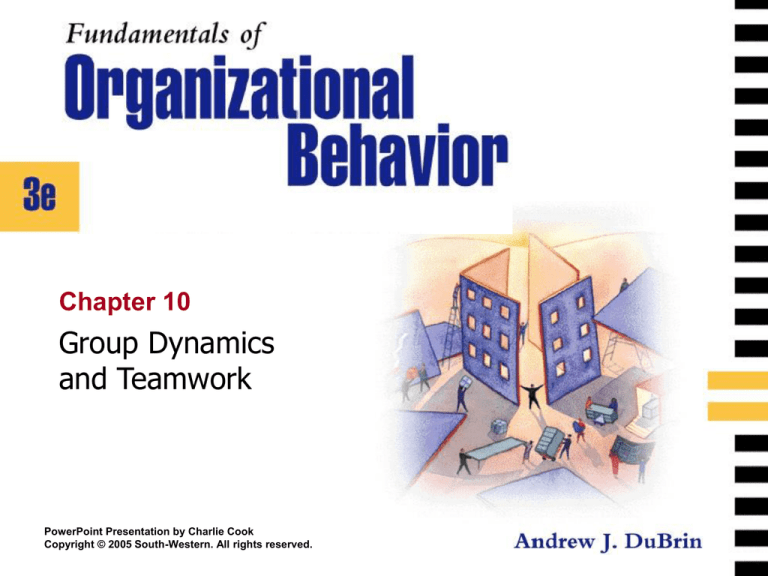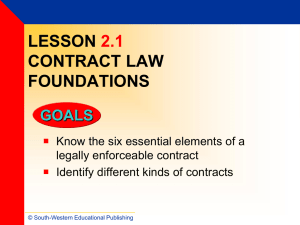
Chapter 10
Group Dynamics
and Teamwork
PowerPoint Presentation by Charlie Cook
Copyright © 2005 South-Western. All rights reserved.
Learning Objectives
After reading and studying this chapter and doing the
exercises, you should be able to:
1. Describe the various types of groups in organizations.
2. Summarize the stages of group development and key roles
members occupy within a work group.
3. Identify characteristics of an effective work group.
4. Implement two different methods of group problem solving
and decision making.
5. Pinpoint several potential problems with group effort and
know how to prevent them.
6. Explain how to foster teamwork.
Copyright © 2005 South-Western. All rights reserved.
10–2
Types of Groups and Teams
• Groups
Interact with one another.
Are working toward some common purpose.,
Perceive themselves to be a group.
Have a strong, focused leader.
Have individual accountability.
Strive to run efficient meetings.
Copyright © 2005 South-Western. All rights reserved.
10–3
Types of Groups and Teams (cont’d)
• Teams
Are a special type of group,
Have complementary skills.
Are committed to a common purpose.
Have a set of performance goals.
Have a defined approach to a task.
Have a team leader who shares leadership roles.
Have individual and mutual accountability.
Encourage open-ended discussion and participation.
Copyright © 2005 South-Western. All rights reserved.
10–4
Types of Groups and Teams (cont’d)
• Formal groups
Are deliberately formed by the organization to
accomplish specific tasks and achieve goals.
• Informal groups
Emerge over time through the interaction
of workers to satisfy a social or
recreational purpose.
Are not sanctioned
but may be tolerated
by the organization.
Copyright © 2005 South-Western. All rights reserved.
10–5
Types of Work Teams
• Cross-functional team
A group of workers with different specialties drawn
from the same level in the organization to blend their
talents to accomplish a task such as product
development.
Have individual members who think in terms of what
is good for the organization and not their specialty.
Copyright © 2005 South-Western. All rights reserved.
10–6
Types of Work Teams (cont’d)
• Top-management team
Is the group of managers at the top of organizations
that collaborate in making most major decisions.
Occasionally, can be a committee of two or more top
executives who claim to share power.
Copyright © 2005 South-Western. All rights reserved.
10–7
Types of Work Teams (cont’d)
• Affinity groups
Are employee-involvement groups composed of
professional-level (or knowledge) workers.
Meet regularly, share information, capture
opportunities, and solve problems affecting their
organizations.
Are self-directing and
have a formal charter
from their organizations.
Copyright © 2005 South-Western. All rights reserved.
10–8
Types of Work Teams (cont’d)
• Virtual teams
Are small groups of people who conduct almost all of
their collaborative work by electronic communication
rather than face-to-face. Members can be located
anywhere in the world.
Advanced “cybercollaboration” techniques:
E-mail
for sharing information and “cybermeetings.”
Groupware
Desktop
for simultaneous document editing.
video conferencing to facilitate the virtual
team.
Copyright © 2005 South-Western. All rights reserved.
10–9
The Stages of Group Development
EXHIBIT 10-2
Copyright © 2005 South-Western. All rights reserved.
10–10
Stages of Group Development
• Stage 1: Forming
A time of confusion, caution, communality for
members.
Group members learn:
What
tasks are expected to be performed.
What
the benefits are of group membership.
What
rules must be followed and expected
behaviors.
Copyright © 2005 South-Western. All rights reserved.
10–11
Stages of Group Development (cont’d)
• Stage 2: Storming
A time of hostility, infighting, tension, and
confrontation.
Members argue to clarify expectations.
Coalitions, cliques, and subgroups form within the
group.
Copyright © 2005 South-Western. All rights reserved.
10–12
Stages of Group Development (cont’d)
• Stage 3: Norming
A period of quiet; resistance is overcome and group
standards (norms) are established.
Cohesiveness and commitment begin to emerge.
Sources of “norms”:
The
group itself sets behavioral and performance
standards.
Organizational
Influential
rules and policies are adopted.
team members who inspire the group.
Copyright © 2005 South-Western. All rights reserved.
10–13
Stages of Group Development (cont’d)
• Stage 4: Performing
In this stage, the group is ready to focus on
accomplishing its key tasks.
Intrinsic motivation and creativity emerge as the
group performs (“working for the cause”).
• Stage 5: Adjourning
Groups are dissolved after their tasks are
accomplished.
• Key managerial challenge:
To help groups move past the first three stages
of group development into performing.
Copyright © 2005 South-Western. All rights reserved.
10–14
Roles within Groups
1. Knowledge contributor
2. Process observer
3. People supporter
4. Challenger
5. Listener
6. Mediator
7. Gatekeeper
8. Take-charge leader
Copyright © 2005 South-Western. All rights reserved.
10–15
Work Group
Characteristics
Related to
Effectiveness
Sources: Michael A. Campion, Ellen M. Papper, and Gina Medsker, “Relations between Work Team Characteristics
and Effectiveness: A Replication and Extension,” Personnel Psychology, Summer 1996, p. 431; Bradley L. Kirkman
and Benson Rosen, “Powering Up Teams,” Organizational Dynamics, Winter 2000, pp. 48–52; Stanley M. Gulley,
Kara A. Incalcaterra, Aparna Joshi, and J. Matthew Beaubien, “A Meta-Analysis of Team Efficacy, Potency, and
Performance: Interdependence and Level of Analysis as Moderators of Observed Relationships,” Journal of Applied
Psychology, October 2002, pp. 819–832; Scott W. Lester, Bruce M. Meglino, and M. Audrey Korsgaard, “The
Antecedents and Consequences of Group Potency: Longitudinal Investigation of Newly Formed Work Groups,” The
Academy of Management Journal, April 2002, pp. 352–368; Vanessa Urch Druskat and Steven B. Wolff, “Building
the Emotional Intelligence of Groups,” Harvard Business Review, March 2001, pp. 80–90.
EXHIBIT 10-3
Copyright © 2005 South-Western. All rights reserved.
10–16
Effective Work Group Characteristics
• Job design
The use of job enrichment and the job characteristics
model to develop self-management capabilities and to
ensure participation in decision-making.
• A feeling of empowerment
The group’s belief in their authority to solve a variety
of problems without first obtaining approval from
management.
Group
experiences: potency, meaningfulness,
autonomy, and impact.
Copyright © 2005 South-Western. All rights reserved.
10–17
Effective Work Group Characteristics
(cont’d)
• Interdependence (Task and Goal)
Increases motivation and the sense of responsibility
for the work of group as members interact and
depend on one another to accomplish the task.
Involves linking individual goals to the group’s goals.
• Team efficacy
The team’s belief that it
can successfully perform
a specific task.
Copyright © 2005 South-Western. All rights reserved.
10–18
Effective Work Group Characteristics
(cont’d)
• Right mix and size
Increasing group diversity improves problem solving.
Groups must be large enough to do the job yet small
enough to maintain internal communications,
cohesiveness, and coordination.
• Emotional intelligence
Teams benefit from members with high emotional
intelligence who build relationships both inside and
outside the team, and understand their environment.
Copyright © 2005 South-Western. All rights reserved.
10–19
Effective Work Group Characteristics
(cont’d)
• Support for the work group
The availability of sufficient resources (e.g., training
and managerial support) is essential to group
success.
• Effective processes within the group
Simply believing that the group can do anything
enhances group effectiveness.
Social support of others, workload sharing,
communication and cooperation all contribute to
group cohesiveness.
Copyright © 2005 South-Western. All rights reserved.
10–20
Effective Work Group Characteristics
(cont’d)
• Group cohesiveness
A group in which members work closely with each
other, in a unified, cooperative manner, is likely to be
effective.
• Familiarity with jobs, coworkers, and the
environment
Effectiveness increases when group members have a
high degree of specific knowledge of their jobs,
coworkers, and the environment.
Copyright © 2005 South-Western. All rights reserved.
10–21
Group Problem Solving and Decision
Making
• Group decision-making styles
Consultative
Group leader consults with the group before
deciding.
Consensus
Manager shares problem with group members
who seek a solution.
Democratic
The group is empowered to make decision
themselves.
Copyright © 2005 South-Western. All rights reserved.
10–22
Steps in the Nominal Group Technique
(NGT)
1. Members of the group are chosen and brought together.
2. If the group is too large, it is divided into subgroups.
3. The group leader presents the question.
4. Individual members independently record their work.
5. Each group member presents one idea without discussion.
6. Once members have presented their viewpoints, evaluate all
of the ideas.
7. The meeting terminates with individuals voting to create a
group ranking of the ideas.
Copyright © 2005 South-Western. All rights reserved.
10–23
The Delphi Technique
• A sequence of questionnaires distributed to
group members from which a solution is derived.
Members answer the questionnaire about the
problem and transmit their responses to a
coordinator.
The leader aggregates the responses, and then
sends them back to the members for feedback.
Problem solving improves with each successive input.
In the last round, group members are asked to vote
for their choice of solutions.
Copyright © 2005 South-Western. All rights reserved.
10–24
Start
Group Problem Solving
and Decision Making:
Problem definition
Steps in the
Delphi Process
Determine expertise required
Sample experts (sample size)
Prepare questionnaire
Distribute questionnaire
Analyze question responses
Yes
Has consensus been reached?
Provide requested information
and tabulate responses
Prepare the next questionnaire
Compile final responses and
disseminate the results (final
report)
Copyright © 2005 South-Western. All rights reserved.
Source: R. J. Tersine and W.E. Riggs, “The Delphi Technique:
A Long-Range Planning Tool,“ Business Horizon (April, 1976):
p. 53. Copyright © 1976 by the School of Business at Indiana
University.
10–25
Potential Problem Within Groups
• Group polarization
Shifts in member attitudes to more or less risky
positions, which, in turn, reduces intragroup cohesion.
• Social loafing
Occurs when an undermotivated person shirks
individual responsibility and tries to squeeze by
without contributing a fair share of the work.
Copyright © 2005 South-Western. All rights reserved.
10–26
Potential Problem Within Groups (cont’d)
• Groupthink
Occurs when strong group cohesiveness creates a
extreme form of consensus and interferes with
effective decision-making.
Contributors to groupthink:
Strong member-group identification
Directive leadership
High stress
Insulation of the group
No built-in mechanism for
evaluating decisions
Copyright © 2005 South-Western. All rights reserved.
10–27
Building Teamwork
1. Instill in teams an urgent constructive purpose.
2. Empower the group to determine how to meet its
objectives.
3. Promote working together
effectively as the norm.
4. Make frequent use of
words and phrases that
support teamwork.
5. Use language the fosters
cohesion and commitment.
Copyright © 2005 South-Western. All rights reserved.
10–28
Building Teamwork (cont’d)
6. Use a consensus decision-making style to foster
participation.
7. Feed members valid facts and information that
motivate them to work together.
8. Avoid micromanagement in supervising the team
too closely.
9. Create physical structures suited for teams.
10. Reward the team as well as individuals.
11. Send members to outdoor (or off-site) training.
Copyright © 2005 South-Western. All rights reserved.
10–29





